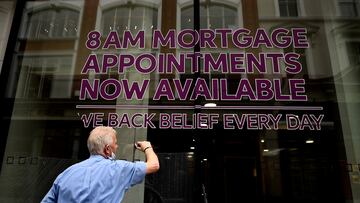How is the failure of SVB affecting mortgage rates?
The Silicon Valley Bank collapse, the second largest in history, sent shockwaves through the economy briefly reversing the upward trend of mortgage rates.

The failure of Silicon Valley Bank at the end of last week was the largest bank collapse since the 2008 financial crisis and the second largest in US history. The demise of the financial institution which caters to tech start-ups and venture capitalists sent shockwaves through the economy and prompted emergency measures from the White House to prevent contagion.
One of the knock-on effects of the turmoil in the banking sector was a drop in mortgage rates which have been rising steadily in recent weeks. The mini banking crisis that played out between Thursday and Tuesday saw the popular 30-year fixed-rate mortgage drop nearly half a percent by Monday. However, the panic in financial markets has eased and mortgage rates across the board were higher on Tuesday but still below their peak last week.
How is the failure of SVB affecting mortgage rates?
It should come as no surprise that bank failures cause panic in the financial markets and investors move funds to safer assets, usually US Treasury notes. So was the case in the wake of Silicon Valley Bank’s collapse which was one of three banks to shutter in rapid succession. Further flight-to-safety ensued when Signature Bank was also closed, the third largest bank failure in history, following the demise of SVB.
Here’s a timeline of the collapse of Silicon Valley Bank, the largest U.S. bank to fail since the 2008 financial crisis https://t.co/gNZ4qY9EIU pic.twitter.com/yBoO4Kd9tj
— Reuters (@Reuters) March 15, 2023
As investors shift their money from riskier assets to bonds, it generally puts downward pressure on interest rates. Additionally, mortgage rate tend to follow the yield on US Treasuries which fell to a one-month low on Monday in the wake of the unfolding banking crisis. The 30-year fixed-rate mortgage daily average went from 7.05 percent on Wednesday to 6.57 percent on Monday according to Mortgage News Daily.
However, the emergencies announced in a joint statement from the Department of the Treasury, Federal Reserve, and Federal Deposit Insurance Corporation (FDIC) appear to be calming some of the jitters about the health of the US banking sector. On Tuesday, shares in banks rebounded and mortgage rates reversed course rising once again with the daily average now 6.75 percent, just 30 basis points lower than the peak last week.
Federal Reserve could pause interest rate hikes
The Federal Reserve, in its fight to control inflation, has been raising interest rates aggressively over the past year. This has been a major driver behind the rapid increase in mortgage rates as well.
Average interest rates for fixed-rate mortgages rise in the week ended March 9: the 30-year to 6.7% and the 15-year to 6.0% https://t.co/gP7vXh1k0F pic.twitter.com/LhOxCxtBSL
— St. Louis Fed (@stlouisfed) March 12, 2023
At last month’s meeting policymakers slowed the pace once again implementing a 25 basis points hike in order to have time to judge the effectiveness of the monetary tightening. However, the US economy has been much stronger and more resilient than expected as well inflation stickier than hoped.
Related stories
This led to hawkish statements from Fed Chair Jerome Powell in testimony before Congress and an expectation that policymakers would implement a bigger-than-predicted interest rate increase when they meet next week. But the mini banking crisis episode may give pause to that action as negative sentiment about the banking sector has not completely gone away.
“The latest banking crisis is likely to force the Fed to pause raising rates in March,” said chief market economist at Spartan Capital Securities Peter Cardillo. “The Fed will need time to monitor the consequences of the latest banking debacle and set aside for now the fight against inflation.”


